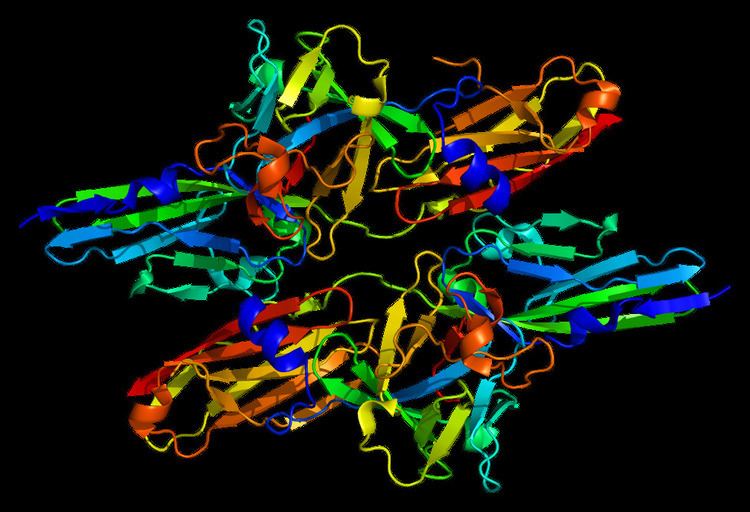Species Human Entrez 2253 | Human Mouse Ensembl ENSG00000107831 | |
 | ||
Aliases FGF8, AIGF, FGF-8, HBGF-8, HH6, KAL6, fibroblast growth factor 8 External IDs MGI: 99604 HomoloGene: 7715 GeneCards: FGF8 | ||
Fibroblast growth factor 8 is a protein that in humans is encoded by the FGF8 gene.
Contents
Function
The protein encoded by this gene is a member of the fibroblast growth factor (FGF) family. FGF family members possess broad mitogenic and cell survival activities, and are involved in a variety of biological processes, including embryonic development, cell growth, morphogenesis, tissue repair, tumor growth and invasion.
Fgf8 is important and necessary for setting up and maintaining the midbrain/hindbrain border (or mesencephalon/met-encephalon border) which plays the vital role of “organizer” in development, like the Spemann “organizer” of the gastrulating embryo. Fgf8 is expressed in the region where Otx2 and Gbx2 cross inhibit each other and is maintained expression by this interaction. Once expressed, the Fgf8 induces other transcription factors to form cross-regulatory loops between cells, thus the border is established. Through development, the Fgf8 goes to regulate the growth and differentiation of progenitor cells in this region to produce ultimate structure of midbrain and hindbrain. Crossely’s experiment proves that the Fgf8 is sufficient to induce the repatterning of midbrain and hindbrain structure.
In the development of forebrain, cortical patterning centers are the boundaries or poles of cortical primordium, where multiple BMP and WNT genes are expressed. Besides, at the anterior pole several FGF family including Fgf3, 8,17 and 18 overlap in expression. The similarity in cortical gene expression in Emx2 mutants and mice in which the anterior FGF8 source is augmented suggests that FGF8 controls the graded expression(low anterior, high posterior) of Emx2 in the cortical primordium. Emx2 is one of the protomap molecular determinants that prove to be closely interacted with Pax6. Emx2 and Pax6 are expressed in opposing gradients along the A/P axis of the cortical primordium and cooperate to set up area pattern. Fgf8 and Emx2 antagonize each other to create the development map. Fgf8 promotes the development of anterior part and suppresses posterior fate, while the Emx2 does the reverse. What's more, FGF8 manipulations suggest FGF8 controls the cortical graded expression of COUP-TF1. Moreover, the sharpness of both COUPTF1 and COUP-TF2 expression borders would be expected of genes involved in boundary specification.Thus, the interaction between them regulates the A/P axis of cortical primordium and directs the development map of cortical area.
Clinical signficance
This protein is known to be a factor that supports androgen and anchorage independent growth of mammary tumor cells. Overexpression of this gene has been shown to increase tumor growth and angiogenesis. The adult expression of this gene is restricted to testes and ovaries. Temporal and spatial pattern of this gene expression suggests its function as an embryonic epithelial factor. Studies of the mouse and chick homologs reveal roles in midbrain and limb development, organogenesis, embryo gastrulation and left-right axis determination. The alternative splicing of this gene results in four transcript variants.
